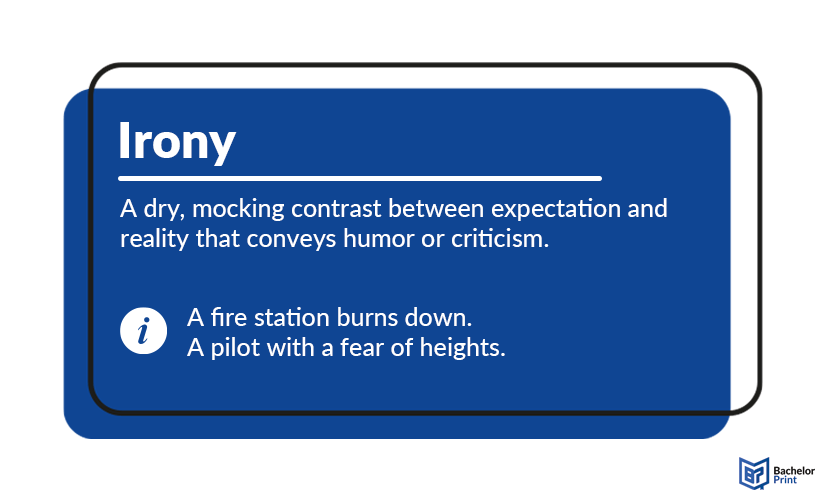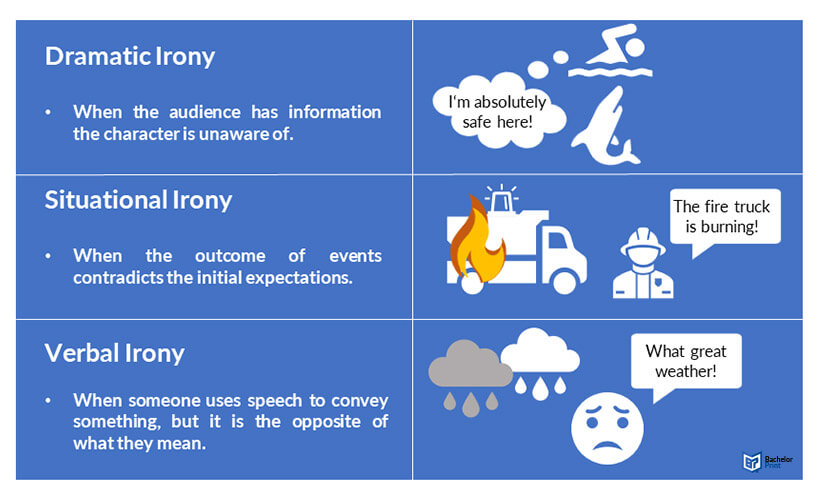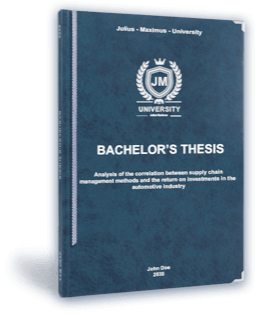
In rhetoric, the concept of irony represents one of the most intriguing, but often misunderstood, stylistic devices. Employed in a statement, it is typically shown as a twist against its literal meaning, expressing the opposite or a different meaning essentially. In accordance, one might wonder how this concept may fit within the evidence-based and structured foundation of academic writing. This article delves into the use of irony in academia without compromising the clarity and integrity.
Definition of irony
In the realm of academic writing, classical irony is a type of rhetorical device, also called a figure of speech or stylistic device. Essentially, a general definition of it is that it conveys the opposite meaning of the literal statement. Henry Watson Fowler, a renowned English grammarian and lexicographer, accounts for a variety of forms of irony, highlighting its nature as a rhetorical device. According to him, it is typically used to reinforce a point or to accentuate a disparity of intention between a statement and meaning, or predictions and results. Additionally, Fowler makes a clear distinction between ironic and sarcastic statements and puts focus on the common misuse of it in general. Therefore, it is crucial to employ this concept thoughtfully to prevent misunderstandings and ensure clarity. Apart from academia, ironic context is often used for criticism, emphasis, or humour and can take on various forms such as dramatic irony, situational irony, and verbal irony.

Examples of irony
The following statement refers to a failed public health campaign event.
This is an ironic statement, as it contrasts the aspiring title of the campaign with its uninspiring outcome of events, emphasizing the failure of the campaign.
Etymology
The origins of irony are in the ancient Greek word “eirōneía,” meaning “feigned ignorance” or “dissimulation.” The conception of irony originated from a character in Greek comedy named “eirōn” who dissembles ignorance with the aim to deceive, exposing someone else’s hypocrisy or ignorance as a result. This concept is now applied to general situations, where there is a notable gap between expectations and the outcome of events.
There are some words that represent synonyms for irony, as they capture various characteristics in terms of its sarcastic and humorous undertones and contradictions of unexpected results. Terms that depict a synonym for irony are listed in the following:
- Asteism
- Bitterness
- Causticity
- Contradition
- Cynicism
- Dryness
- Incongruity
- Mockery
- Paradox
- Parody
- Ridicule
- Sarcasm
- Sardonicism
- Satire
- Sharpness
- Wit
Ironic statements in academic writing
When we speak of ironic context in an academia, it’s primarily applied in its literary and rhetorical aspects. Therefore, it is noteworthy that ironic statements should not be included in academic writing unless they are drawn from relevant scientific sources or the content itself. The following illustrates an overview of ironic context used in scholarly debates and discussions. These types reflect on nuanced ways in which irony is applied in fields such as philosophy, history, and literature, and will be elaborated on in this article.
-
Cosmic irony:
Revolves around the belief that destiny, fate, or a god-like superior power is in control and deliberately plays around with the hopes and expectations of humans. -
Dramatic irony:
Refers to a literary device where the audience is aware of facts and situations, while the characters are left in the unknown. -
Historical irony:
Emphasizes sharp and significant contrasts between historical and present events, pointing out definite changes in circumstances and values. -
Metafiction:
Represents a stylistic device of postmodernism with the distinct characteristic of generally distrusting concepts, theories, and any ideas of “reality.” -
Romantic irony:
Refers to the method or technique of the narrative constantly reminding the reader of the literary state of the work or the artificiality. -
Situational irony:
Depicts scenarios in which the actual outcome of an occurence turns out to be completely different than what was initially expected. -
Socratic irony:
A technique that Socrates implemented by pretending to be clueless or ignorant to expose contradictions or weaknesses in someone’s argument. -
Verbal irony:
The deliberate way of stating something that is the opposite of what is meant, typically used to emphasize something or cobvey humour.
Dramatic irony
Often used in films, plays, and literature, dramatic irony is a stylistic device where the audience has more information about a situation than the actual characters. This often creates a certain humorous tension due to the contrast between the audience’s knowledge and the characters’ reality. The underlying purpose is to enrich the emotional effect and enhance the narrative experience.
Dramatic irony example
William Shakespeare’s most famous play, “Romeo and Juliet,” entails a perfect example of dramatic irony.
In this example, the emotional intensity is enhanced, as the audience has been aware of Juliet’s plan to take the potion to merely appear dead all along, thus, understanding the tragic mistake long before the characters do.
Tragic irony
Tragic irony refers to a subtype of dramatic irony, and thus, they are often used interchangeably. As the name says, it refers to a form of dramatic ironic context found in tragedies. In these scenarios involving tragic irony, the audience is specifically aware of a tragedy that is about to happen, while the characters remain clueless. This creates a suspenseful intensity for the audience, as they await the impending doom of the characters.
In this scenario, the audience is aware of the true identity of Oedipus and the prophecy. Thus, they watch him unwittingly condemn himself, seeking the murderer who is, in fact, himself. When the truth comes to light, it causes a tragedy for Oedipus and his family, highlighting the tragic irony of his situation.
Situational irony
Situational irony is found in situations where the expected results do not align with the actual events. It happens when there is a discrepancy between what is expected to occur and what transpires in reality, oftentimes ending in unexpected results that are thought-provoking or humorous. In other words, when an effect of actions turns out to be the opposite of what was initially anticipated.
Situational irony example
The following short story “The Gift of the Magi” by O. Henry provides an accurate example.
The situational irony comes to light when they exchange gifts on Christmas. They have each made their gift pointless by selling their cherished items necessary for their gifts to each other. Essentially, their actions caused the opposite effect of their intentions, resulting in an unexpected outcome.
Types of situational ironic context
The following accounts for subtypes of situational ironic context and where they commonly occur.
Cosmic irony, also called irony of fate, describes the idea that fate, gods, or the universe manipulate the destiny of humans’ hopes and expectations maliciously. It refers to characters believing they are controlling their fate, but learning they are wrong due to external higher powers. Cosmic irony usually emphasizes that life can’t be foreseen and that fate can’t be altered or controlled, visualizing the contrast between human anticipation and the higher, inevitable, and cruel design of the cosmos. The Greek myth of King Sisyphus illustrates a perfect example of cosmic irony.
Sisyphus’ belief that he cheated the gods and was controlling his fate, but actually being subjected to an endless and pointless task as a punishment by the gods, shows a cruel lesson. Essentially, he is not only tortured physically but also in the psychological torment of never reaching his goal, no matter how often or hard he approaches the task. This emphasizes a cruel lesson that humans cannot escape their fate.
When a situation in history has an inappropriate outcome or the opposite of what was expected, we speak of historical irony. This type of irony occurs when we reminisce about past situations with the realisation that the beliefs, expectations, or intentions of people back then do not align with the eventual or perceived outcomes in retrospection. It can often be depicted in the unexpected consequences of specific actions, the evolution of societal values, and advancements in technology. The Maginot Line in France tells the perfect tale for an example of historical irony.
Although the Margot Line was a technologically advanced defensive barrier, forcing the Germans to go around it, it ultimately allowed the German forces to navigate through the Ardennes Forest, which was considered a natural defence structure and therefore barely reinforced. This becomes ironic as the very defence plan that France relied on, essentially, paved the way for the German invasion and resulted in rapid defeat.
Verbal irony
Verbal irony is employed in speech where someone states one thing but means the opposite. This is typically used to convey a certain attitude or message that contradicts the initial literal statement. In scenarios involving verbal irony, the listener is mostly aware of the inconsistency between the said words and the intended meaning, setting a humorous or critical tone. Ultimately, verbal irony clearly differentiates between what is stated and what is actually meant.
Verbal irony example
A verbal irony example can be identified in a setting and a contradicting statement, as in the following.
Based on the setting, it is clear that the person does not refer to the weather as wonderful, as this describes the complete opposite. The speaker employed verbal irony to emphasize how bad the weather is. The ironic intent behind it, is also clear, as the setting and the statement do not coincide.
Types of verbal ironic context
The subsequent discourse outlines the most frequently occurring forms of verbal ironic context.
Sarcasm refers to a type of verbal irony, where insincere or mocking language is employed to express disregard, mockery, or contempt. The tone is often biting, cutting, or sharp with the deliberate intention to convey scorn toward the listener. While sarcasm is typically ironic, irony isn’t always sarcastic. Sarcasm has a more specific intent, which goes in the direction of taunting or purposefully hurting someone in a malicious or humorous way. The following outlines a simple example of sarcasm.
In this case, of verbal irony, the boss is not genuinely praising the employee for attending the meeting, but rather makes a sarcastic remark to scornfully emphasize the person’s late arrival. While superficially, this statement would be welcoming, on a deeper level, it is actually a critique of the person’s tardiness.
An echoic allusion is a rhetorical device and also a form of verbal irony. It involves the writer making a reference to or reflecting back on a previous word, sentence, or phrase, usually, from a widely known event or text. It can be referred to as a form of intertextuality, as one text resonates with another. This type of allusion aims to evoke the emotions or atmosphere associated with the original source by echoing it. This enables the writer to express meanings between the lines without stating them directly. When using echoic allusion, the writer has the belief that the audience has knowledge of the original source, which creates a mutual understanding or cultural link. T.S. Eliot’s poem “The Waste Land” illustrates a famous example of echoic allusion.
While Chaucer gives the April month a positive connotation by celebrating growth and rejuvenation, Eliot’s echoic allusion to it portrays the contrary modern version, implying that April interferes with the natural flow of winter. As Eliot echoes Chaucer’s line, it is apparent that he assumes the audience is familiar with “The Canterbury Tales.”

Using irony
While logic, clarity, and evidence portray key aspects in the realm of academic writing, it may be difficult to see ironic statements as complementing companions. Irony can offer an effective way to convey and emphasize contradictions, challenge traditional norms, or provide a more profound meaning to an argument. When used appropriately and with precision, irony can elevate an academic paper by presenting deliberate intention or even elaborating critique. There are various ways to use irony, which are delved into in the following.
Using comic irony includes giving expectations of an event or situation and adding an unexpected twist with the aim of creating a comedic or humorous effect. In essence, it occurs when an absurd or unexpected result of something makes you laugh. This is how it can be used:
-
Build up expectations:
Construct a specific setting for the audience that gives them certain expectations of the outcome of a situation or events. -
Add a twist:
Introduce something that strongly contradicts the expectations of the outcome, establishing a punchline or a twist in the argument. -
Keep clarity:
Maintain the irony and clarity for the audience. A weak or subtle presence of the ironic twist may diminish the comedic effect. -
Thoughtful timing:
Perfect timing plays a key role in comedy. Set the ironic twist as soon as possible after the establishment of the expectations for a stronger effect. -
Adjust to your audience:
Make sure you know your audience. Humor varies immensely, tailor your comic irony to the target group you are confronted with.
Consider the following example for a better comprehension of comic irony.
In this scenario, the irony is comic or humorous, as the host urges punctuality through the event and contradicts himself by being late.
Metafiction and romantic irony are closely related and anticipate to highlight the constructed nature of a narrative. However, these two concepts have slight distinctions, which become apparent below.
When a writer uses metafiction, they remind the audience that what they read is fictional and doesn’t represent an unmediated part of reality. Essentially, metafiction is a form of fiction that assertively addresses and uncovers the construction behind the story. Employing metafiction can be done in three ways as accounted for in the following:
- The narrator or characters can directly acknowledge that they are part of a fictional story, e.g., “If this were a novel, I’d be dead.”
- The narrative can be disrupted by commentary based on the author’s revisions, direct addresses to the reader, or simply notes.
- Blur the lines by mixing real-life and fictional elements, e.g., integrating real photos, footnotes, or documents in the fictional narrative.
Kurt Vonnegut’s “Slaughterhouse-Five,” depicts a clear example of employing metafiction by blurring the lines, as follows.
On the other hand, romantic irony or self-irony refers to the self-awareness of the author, meaning their subjective position in constructing a narrative. This type of irony describes how an author is completely involved in the process of creation, whilst also able to critique or mock it. Among others, romantic irony can be employed in the following three ways:
- The author is fully immersed in the narrative, however, detached to a certain level to offer commentary at the same time.
- Disrupting the narrative by fragments of various voices, plots, or views to convey the point that multiple truths are possible.
- The author may integrate playful critique by praising a scene and then mocking it or downplaying its importance in the next breath.
The German poet and philosopher Friedrich Schlegel often employed romantic irony and set clear examples for it in his way of argumentation and conceptualizing.
In essence, the most prominent distinction between metafiction and romantic irony is the balance between engagement and detachment.
Derived from Socrates in Platonic dialogues, Socratic irony revolves around pretending to be clueless about a dissembled belief in an opponent’s argument to expose the flaws in their claim. Socrates often positioned himself in the role of the clueless one, inquiring for clarification of a topic that he was already knowledgeable of. In the quest of seeking clarity, he tailored the questions in a way to make the opponent realise their contradictions regarding their beliefs, ultimately, providing a deeper understanding and insight into philosophical truths. Overall, it can be employed as a pedagogical method to guide someone to acknowledge inadequacies on their own by questioning them.
Using Socratic irony is an effective way to navigate discussions, amplify critical thinking, and enlighten people about the flaws in their arguments. There are several ways to employ this type properly:
-
Pretending to be clueless:
Ask questions about a topic you are already familiar with. This creates a safe environment for others to share their opinions. -
Open-ended questions:
Formulate questions in a way that promotes elaboration, like “How did you draw this conclusion?” or “Can you elaborate?” -
Request clarity:
This may urge people to reflect on their argument, e.g., if someone states, “All athletes are cheaters,” ask, “Do you think there is not one honest athlete?” -
Subtly emphasize contradictions:
Encourage self-recognition by asking questions instead of directly confronting a contradiction made in an argument. -
Stay humble in your tone:
Remember that it isn’t about being right in an argument, but rather about navigating the person toward a self-realisation of contradictions. -
Be mindful of the timing to conclude:
The process of drawing a conclusion varies for every person. Thus, wrapping up a discussion effectively may involve leaving the person with food for thought.
The following example displays this Socratic approach in a modern context.
The example above illustrates open-ended questions that can help in guiding the discussion. In addition, these questions encourage the opponent to employ critical thinking and reevaluate their viewpoint on their own, possibly, acknowledging any gaps in their argument.
Negative irony acts as the counterpart of humorous or neutral irony. Its purpose lies in conveying critique, contempt, or a negative connotation through arguments that express the contrary to what is actually meant. This form of irony is often found in literature, everyday dialogue, or rhetoric, referring to contradictions or errors in a topic. Negative irony can be used in several ways:
-
Provide a clear context:
In order to avoid confusion and convey a point effectively, it is crucial to provide a clear context for an ironic statement. -
Setting the right tone:
In terms of negative irony or sarcasm, it may be effective to use a disdainful or mocking tone to make the irony clear. -
Emphasize contradictions:
Negative irony should directly point out inconsistencies in actions, situations, or beliefs. This is frequently done by placing the statement and intent side by side. -
Keep it short:
Brief ironic statements can oftentimes be more effective than extensive ones, as they will keep the focus to the point. -
Use it appropriately:
Make sure you employ negative irony in the right context and not excessively. Using it too often may come off as not serious or too cynical. -
Expect strong reactions:
It is essential to remember that you may receive strong feedback when using negative irony, as it is often provocative.
Despite the company’s trying, the statement above clearly conveys criticism towards it, indicating the efforts are too minimal, especially, in terms of its prior backlash.
Using awkwardness in terms of irony revolves around creating an uncomfortable setting or drawing attention to unpleasant situations so that the audience is forced to acknowledge the breach between expectations and actual results. By reinforcing emotional reactions, awkwardness can bring irony more to the foreground, making it more tangible to the crowd. Awkwardness can be employed in many ways to intensify irony:
-
Create unexpected settings:
Awkwardness typically occurs when a situation is inappropriate or unexpected. Therefore, contrasting normality with something unexpected in a setting may be effective. -
Be aware of the dynamic between characters:
If the character is clueless about certain information, but the audience is familiar with it, it may create an ironic and awkward situation. -
Playful timing:
Be suspenseful with answers and responses, which can create an awkward silence between scenes and intensify the irony. -
Add a twist to social norms:
We are taught by social conventions what is normal and what is out of line. Creating scenarios that go against the norm may lead to awkwardness. -
Restrict what is said:
Often, silence can be much more awkward than spoken words. Be calculated with pauses, body language, and the setting. -
Point out gaps:
Make sure to emphasize the breach between expectations and reality. The more the breach comes to the foreground, the more awkward the situation will be.
Misusing irony
To identify and prevent the misuse of common irony is vital, as it often leads to miscommunication, confusion, or even unintended offence . The most frequently made mistakes in using common irony are outlined below.
-
Too subtle:
Despite subtlety being a crucial part of conveying ironic meanings properly, it still has to be noticeable to the audience. If it is employed too subtly, it can create confusion. -
Overuse:
Overusing ironic statements can come off as insincere or elusive. It makes it more difficult for the audience to differentiate between genuine sentiment and irony. -
Inappropriate setting:
Be careful about using ironic statements in sensitive or serious contexts, as it can quickly become dismissive of the sensitivity or disrespect towards a certain topic. -
Cultural misconceptions:
Not all cultures have the same understanding and employment of irony, meaning that while one culture uses ironic context one way, another could perceive it as deceptive or confusing. -
Irony vs. sarcasm:
Sarcasm is often confused with irony, which often results in unintentional offence . Sarcasm is a subtype of verbal irony, however, not all ironic statements can refer to sarcasm. -
Language barriers:
When translating ironic statements to other languages, the nuances may get lost, resulting in misunderstandings or confusion. -
Digital communication:
In text messages, the tone is missing in the communication, which can frequently lead to confusion or even unintended offence when employing irony.
Based on the points accounting for common misuse of ironic statements, the following repercussions may be most likely to occur.
- Dismissing the seriousness of a situation
- Loss of credibility by seeming insincere
- Miscommunication and confusion
- Unintentional offence
- ✓ 3D live preview of your individual configuration
- ✓ Free express delivery for every single purchase
- ✓ Top-notch bindings with customised embossing

FAQs
Essentially, ironic expressions describe arguments that have a clear literal meaning but nasty the opposite or something else.
For example, if it is a gloomy and rainy day, you might say “What amazing weather!”
Here, the exaggerated remark as a response to the bad weather conveys the opposite.
Ironic statements can be employed in literature and in everyday life. A simple definition of irony is that it refers to a gap between our expectations and the reality of an outcome, or whenever a person says or does something that doesn’t align with our expectations, an ironic expression occurs.
Irony refers to a stylistic device, more specifically, a literary device. In a literary context, it refers to the difference between what something seems to nasty in contrast to its literal meaning, ultimately, pointing out a disparity of intention.
To detect irony, it is crucial to analyse whether the character making a statement, conflicts with the setting on purpose or unintentionally.
For example, if the character intentionally uses a mocking style in tone, it may indicate sarcasm, a subcategory of verbal irony. However, if the intent behind the statement is genuine, it may imply situational irony.
The word “irony” originates from the Greek comic character Erion. He describes a character who, with his intellect, continuously wins against the pretentious character Alazon.
